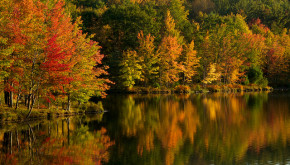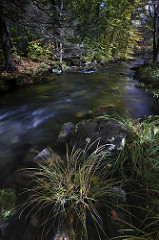
By Ethel Wilkerson, Senior Program Leader, Manomet
Over the last two decades, New England has experienced significant changes in its weather, and these changes are expected to continue over the next century and beyond [1]. The region is predicted to become warmer and wetter on average, storms more frequent and intense, and with more frequent periods of extreme heat and drought. These changes will alter forests by increasing the frequency and size of forest disturbance events, worsening the impacts of invasive and non-native plant and pest species, shifting distributions of tree species and wildlife habitats, challenging the forest resources economy, and changing the way the public uses and values forests. Although we cannot control these changes in climate, we can work locally to shape and sustain forest lands and their contributions to local communities into the future.
The notion of taking action on climate change can be overwhelming. Landowners need practical tools to help maintain healthy forests into the future. To help with this effort Manomet, a non-profit organization, developed a Weather-Wise Worksheet for private landowners to provide tangible steps to respond to climate change on your woodland.
The worksheet provides a suite of strategies and on-the-ground practices, some simple and some more complex, to make your forestlands healthy and more resilient to changes in weather and climate. Landowners and managers are encouraged to pick and choose strategies and on-the-ground practices that are practical and relevant for your forest.
The Weather-Wise worksheet lays out four steps to help prepare forestlands for climate change:
Step 1 – Prepare for Change.Learn about predicted changes in weather and climate and how your properties might be affected.
Step 2 – Plan for Change.Develop a plan for your forests that guides you to action.
Step 3 – Apply Key Strategies and Relevant Best Management Practices (BMPs).Select from a suite of strategies and on-the-ground practices, ranging from simpleto more complex, to make your lands more resilient tochanges in weather and climate. Although climate change is already affecting forests in New England, modest changes in management may be sufficient in the short-term.
Step 4 – Monitor and Adjust.Develop a cost-effective monitoring plan to determine whether impacts of changing weather and climate are occurring on your parcel and whether you are making the adjustments necessary to reduce impacts.
The weather-wise worksheet identifies major topic of concerns climate change including forest health, wildlife habitat, recreation impacts, and human health and safety, then provides specific strategies and best management practices for each topic that may be implemented at your woodland.
As an example, two of the Weather-Wise Workbook strategies for protecting forest health are detailed below:
Strategy #1: Minimize negative impacts of disturbance events
The frequency and intensity of forest disturbances is predicted to increase with climate change, resulting in a decline of habitat and amenity values, changing recreational opportunities, and financial loss. To minimize the negative impacts of disturbance events:
- Be on the lookout for invasive plants and pests after disturbances such as ice storms or wind damage.
- Consider the vulnerability of softwoods and other shallow-rooted trees, forest edges, ridgelines, and riparian buffers to disturbance events when planning timber harvests, recreational trails, or access points.
- Consider harvesting trees and stands most vulnerable to disturbance sooner rather than later. This may help create more diverse stands with a variety of tree of different ages and sizes.
- Encourage growth of native trees that are predicted to thrive in new weather conditions through appropriate silviculture and planting (with appropriate follow-up to ensure survival).
- Understand the range of potential options for managing major disturbance events including pest infestations, wildfire threats, exotic plants threats, and major windthrow. Depending on your goals and objectives for your woods, actions can include allowing stands to naturally transition, conducting salvage harvesting after a disturbance, or preemptively harvesting the most vulnerable trees and stands to reduce potential damage and establish a more resilient forest.
Strategy #2: Maintain native plants and trees
Invasive plants are expected to thrive in a changing climate, allowing them to quickly spread and outcompete native forest plants and animals. To help reduce the spread of invasive plants and pests:
- Learn about existing and emerging threats of invasive plants and insects in your area.
- Develop a simple monitoring program for invasive plants and pests such as knowing which forest stands have invasives and do what degree (e.g. absent, some, a lot). It may be sufficient to focus on invasive “hot spots” which include roads, trail, and disturbed areas.
- Control invasives at the early stages of infestation.
- In areas where invasive plants are abundant, consider how timber harvesting may expand existing populations of invasives. After timber harvests, additional action may be needed to prevent invasives from interfering with regeneration of native species.
- In areas with existing invasive forest plants or pests, consider participation in efforts to use biological controls to manage these species.
- In areas of high deer density, use appropriate silviculture, tree shelters, exclusion pens, or other means to ensure the establishment and survival of saplings of native trees.
You may find that you have already applied some of these practices and, therefore, have begun preparing and responding to climate change.Tweaking existing management strategies can provide practical and cost-effective ways to minimize changes associated with climate change and help ensure that your woodlands continue to provide benefits for you and future generations.
In addition to the Weather-Wise Workbook, there is also a Resource Guide that provides additional information on strategies and recommended actions. There are five Weather-Wise Worksheets in all for different forest types and owners: 1) Private Woodland Owners, 2) Land Trusts and Community Forests, 3) Homeowners, 4) Urban Forests, and 5) Urban Forests and Community Planning (available here: https://www.manomet.org/program/sustainable-economies/creating-resilient-urban-and-community-forests).
Funding for this project was provided by USDA Forest Service, as recommended by the National Urban and Community Forestry Advisory Council in 2010. It was a collaboration of Manomet, the City of Bath, the Maine Forest Service, the Kennebec Estuary Land Trust, the Brunswick-Topsham Land Trust, and the Forest Guild. Our findings do not necessarily reflect the views of the U.S. Forest Service.
Manomet believes that people can live and work today in ways that will enable our world to thrive and prosper tomorrow. By applying science and engaging people, Manomet provides practical ways to act—where people live and work. A nonprofit grounded in science, Manomet champions better practices in conservation, business sustainability, and science education in the U.S. and internationally.
____________________________________________________
For more information, please contact:
Ethel Wilkerson
Senior Program Manager
207-721-9040 ext. 103
[email protected]
[1]Frumhoff, P. C., J. J. McCarthy, J. M. Melillo, S. C. Moser, and D. J. Wuebbles. 2007. Confronting Climate Change in the U.S. Northeast: Science, Impacts, and Solutions. Synthesis report of the Northeast Climate Impacts Assessment. Cambridge, MA


